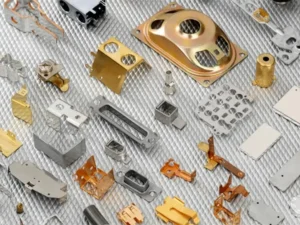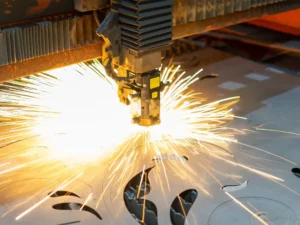مقدمة:
إن القطع بالليزر شائع جدًا بسبب تنوعه. تعد آلة القطع بالليزر الليفي آلة القطع الرئيسية المستخدمة في تقنية القطع في السوق. يتم استخدامها على نطاق واسع بسبب نطاق القطع الواسع وسرعة القطع السريعة وتأثير القطع الجيد وعدم الحاجة إلى الصيانة. خاصة في قطع مواد الصفائح المعدنية، تتمتع آلات القطع بالليزر الليفي بمزايا أكثر. إذن، ما هي المواد التي يمكن قطعها بالليزر؟
ما هي المواد التي يمكن قطعها بالليزر؟
آلات القطع بالليزر الليفي يمكنها قطع العديد من المواد ولكنها ليست غير قابلة للتدمير. تشمل مواد المعالجة الشائعة لآلات القطع بالليزر الليفي الفولاذ المقاوم للصدأ والفولاذ الكربوني والألمنيوم والنحاس والتيتانيوم وما إلى ذلك.

فيما يلي ملخص للمواد التي يمكن لآلات القطع بالليزر قطعها.
الكربون الصلب
يمكن قطع ألواح الفولاذ الكربوني بسمك يصل إلى 25 مم باستخدام تقنية الليزر. ويمكن استخدام آلية القطع بتدفق الأكسدة للتحكم في خط القطع للفولاذ الكربوني ضمن نطاق عرض مرضي. ويمكن أن يكون الشق ضيقًا بحوالي 0.1 مم للألواح الرقيقة.
سبائك الفولاذ
يمكن قطع معظم الفولاذ الهيكلي السبائكي وفولاذ الأدوات السبائكي بالليزر للحصول على جودة حافة جيدة. سوف تتأكسد حافة القطع قليلاً عند استخدام الأكسجين كغاز للتصنيع. بالنسبة للألواح التي لا يتجاوز سمكها 4 مم، يمكن استخدام النيتروجين كغاز معالجة للقطع عالي الضغط. في هذه الحالة، لن تتأكسد حواف القطع. بالنسبة للألواح التي يزيد سمكها عن 10 مم، يمكن تحقيق نتائج أفضل من خلال وضع الزيت على سطح قطعة العمل أثناء المعالجة.
الفولاذ المقاوم للصدأ
القطع بالليزر هو طريقة معالجة فعالة لصناعات التصنيع التي تركز بشكل أساسي على ألواح الفولاذ المقاوم للصدأ. في ظل حالة التحكم الصارم في مدخلات الحرارة للقطع بالليزر، يمكن الحد من عرض المنطقة المتأثرة بالحرارة في حافة القطع، وبالتالي ضمان مقاومة التآكل الجيدة للفولاذ المقاوم للصدأ.
سبائك الألومنيوم
بالنسبة لقطع الألمنيوم وسبائكه بالليزر، يتم استخدام الغاز المساعد بشكل أساسي لنفخ المنتجات المنصهرة في منطقة القطع، مما يؤدي إلى جودة قطع أفضل. يجب توخي الحذر مع سبائك الألمنيوم لمنع حدوث شقوق دقيقة على سطح الشق. تتمتع سبائك الألمنيوم بانعكاسية عالية وموصلية حرارية، ولكن يمكن قطع مواد الألمنيوم التي يقل سمكها عن 6 مم. يعتمد هذا على نوع السبائك وقوة الليزر. عند استخدام الأكسجين، يكون سطح القطع خشنًا وصلبًا؛ ويكون سطح القطع أملسًا عند استخدام النيتروجين. يصعب قطع الألمنيوم النقي ولا يمكن قطعه إلا إذا تم تركيب جهاز "ممتص الانعكاس" على النظام. وإلا، يمكن أن تتسبب الانعكاسات في إتلاف البصريات.
النحاس، النحاس الأصفر
النحاس له قدرة عالية على الانعكاس، مما يجعل القطع باستخدام شعاع الليزر الليفي مستحيلاً. يجب استخدام طاقة ليزر أعلى عند قطع النحاس الأصفر، ويجب استخدام الهواء أو الأكسجين كغاز مساعد لقطع الألواح الرقيقة. يتمتع كل من النحاس النقي والنحاس الأصفر بقدرة عالية على الانعكاس وموصلية حرارية جيدة جدًا. يمكن قطع النحاس الأصفر بسمك أقل من 1 مم باستخدام النيتروجين؛ ويمكن قطع النحاس بسمك أقل من 2 مم، ويجب استخدام الأكسجين كغاز للمعالجة.
التيتانيوم
يتحد التيتانيوم النقي جيدًا مع طاقة الحرارة المحولة بواسطة شعاع الليزر المركّز. عند استخدام الأكسجين كغاز مساعد، يكون التفاعل الكيميائي عنيفًا، وتكون سرعة القطع سريعة. يمكن أن يضمن استخدام الهواء كغاز مساعد جودة القطع. يتميز القطع بالليزر لسبائك التيتانيوم المستخدمة عادةً في تصنيع الطائرات بجودة جيدة. على الرغم من وجود القليل من البقايا اللاصقة في أسفل الفجوة، إلا أنه من السهل إزالتها.
ما هي المواد التي لا يمكن قطعها بالليزر؟

على الرغم من أن آلات القطع بالليزر الأليافي تتمتع بالعديد من الميزات الجيدة، إلا أنها ليست كل شيء.
- لا يمكن استخدامها إلا لمعالجة المعادن ولا يمكن استخدامها لمعالجة المواد غير المعدنية، مثل الحجر والقماش والجلد وما إلى ذلك. والسبب هو أن نطاق الطول الموجي لآلة القطع بالليزر الليفي لم يعد ضمن نطاق الامتصاص. هذه المادة غير مناسبة للامتصاص ولا يمكنها تحقيق التأثير المتوقع.
- ثانيًا، لا تستطيع آلات القطع بالليزر الليفي قطع ألواح الكثافة. آلة القطع بالليزر الليفي هي عملية معالجة حرارية. سيؤدي قطع لوح الكثافة إلى الاحتراق، وستحترق حواف القطع ولا يمكنها تلبية متطلبات القطع.
- هناك أيضًا بعض المواد شديدة الانعكاس. يمكن قطع هذه المواد باستخدام آلة قطع الليزر الليفي. ومع ذلك، فإن الطول الموجي لليزر يقع خارج نطاق الامتصاص المثالي لهذه المواد. سوف ينعكس جزء من الطاقة، وستحترق العدسة الواقية. وهذا أيضًا أمر يجب ملاحظته.
اتجاه التطوير المستقبلي لآلات القطع بالليزر الليفي
تتميز نماذج آلات القطع بالليزر الليفي الموجودة حاليًا في السوق بمزايا واضحة، خاصة لقطع الصفائح الرقيقة. على سبيل المثال، يمكنها معالجة الكربون والفولاذ المقاوم للصدأ بدقة أقل من 20 مم. قطع الصفائح السميكة هو اتجاه التطوير المستقبلي. تطورت تقنية القطع بالليزر الليفي جنبًا إلى جنب مع تطور صناعة معالجة الصفائح المعدنية وتلعب دورًا مهمًا في تعزيز تقدم الإنتاج الاجتماعي.
بالإضافة إلى آلات القطع بالليزر العادية، يتزايد أيضًا الطلب على أنظمة القطع بالليزر عالية الأداء مثل آلات القطع بالليزر عالية السرعة وعالية الدقة، وآلات القطع بالليزر ذات الألواح السميكة كبيرة الحجم، وآلات القطع CNC ثلاثية الأبعاد.
في المستقبل، ستتطور بلا شك آلات القطع بالليزر في اتجاه الطاقة العالية والحجم الكبير والكفاءة العالية والتشكيل لمرة واحدة والذكاء العالي. سيتم استخدامها على نطاق واسع في القاطرات والصناعات الثقيلة وما إلى ذلك. إنها توفر كفاءة عالية وإنتاجًا عالي الجودة لمعظم المستخدمين. تعد آلة القطع بالليزر فائقة الفعالية من حيث التكلفة هي الخيار الأفضل لصناعة المعالجة.
